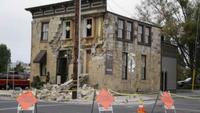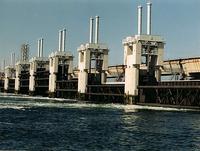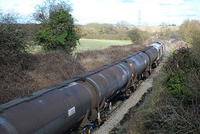-
SF posting seismic warning posters on vulnerable buildings in a retrofitting drive

In an effort to get property owners to retrofit vulnerable buildings, San Francisco is posting large signs — in English, Spanish, and Chinese, with red letters, and a drawing of a collapsed building — on apartment and hotel complexes that have failed to comply with the city’s seismic safety laws.The San Francisco tactic is similar to what city officials in Berkeley implemented in 2005, when building authorities placed small warning signs on at-risk wooden apartment buildings.
-
-
Simulating the ground motion of the south Napa earthquake
Lawrence Livermore National Laboratory (LLNL) seismologists are tapping into LLNL’s supercomputers to simulate the detailed ground motion of last month’s magnitude 6.0 south Napa earthquake. The Napa tremor is the largest to hit the Bay Area since the magnitude 6.9 Loma Prieta event in 1989. Seismic simulations allow scientists better to understand the distribution of shaking and damage that can accompany earthquakes, including possible future “scenario” earthquakes.
-
-
Preparing the next generation of nuclear emergency responders
The catastrophic failure of Japan’s Fukushima I Nuclear Power Plant in March 2011 was a turning point in how the scientific community viewed nuclear emergencies. Up to then, the emphasis had been on prevention, not response. Virginia Tech’s Sonja Schmid has won a 2014 National Science Foundation Faculty Early Development (CAREER) Award to study the prospects and problems of creating a global nuclear emergency response plan. Key issues to be addressed in her research are how to convince the world that any nuclear accident is everybody’s problem and how to mobilize an effective international response.
-
-
Silicon Valley tech startups developing earthquake early warning mobile apps
Silicon Valley tech startups are developing mobile applications to alert residents about earthquakes, but most lack a direct source to the seismic sensors deployed by the state’s ShakeAlertsystem which sends alerts seconds before the ground begins to shake.Googleis currently the only tech company with an agreement to access ShakeAlert’s data feed, and analysts anticipate that Google will integrate ShakeAlert’s system with its Nestthermostat, a Web-connected thermostat that sends alerts to users’ phone and e-mail with details on home temperature and energy use.
-
-
Tornadoes occurring earlier in Tornado Alley
About 1,300 tornadoes hit the United States every year, killing an average of sixty people. Peak tornado activity in the central and southern Great Plains of the United States is occurring up to two weeks earlier than it did half a century ago, according to a new study whose findings could help states in “Tornado Alley” better prepare for these violent storms.
-
-
Cities seek new ways to cope with sea level rise – and look to the Dutch for advice

Scientists predict a “tenfold increase” in the frequency of hurricanes and other storms, as well as sea-level rise of eleven to twenty-four inches within a little more than three decades – and planners and managers in U.S. coastal cities are looking at new ways to prepare their cities’ infrastructure for these challenges. In New York and New Orleans, city planners are studying the experience of the Dutch, who have gained a lot of experience – and fame — for their water control methods.
-
-
Strengthening the armor for nuclear-waste eating microbes
A microbe developed to clean up nuclear waste and patented by a Michigan State University researcher has just been improved. Researchers had identified that Geobacter bacteria’s tiny conductive hair-like appendages, or pili, did the yeoman’s share of remediation. By increasing the strength of the pili nanowires, she improved their ability to clean up uranium and other toxic wastes.
-
-
West Virginia mulls releasing crude oil shipment information to the public

In May 2014, the U.S. Department of Transportation(DOT) ordered railroads operating trains carrying more than one million gallons of Bakken crude oil to notify state emergency officials in states through which oil-carrying trains travel of the expected movement of such trains. The order came to allow first responders to be better prepared should an accident occur. CSX Corporation agreed to share shipping information with West Virginia officials, but refused to release the information to the public citing concerns about terrorism. DOT made it clear that citing terrorism concerns does not exempt crude oil shipment information from being released to the public.
-
-
Rural towns lose to urban centers in competition for coastal protection funding
Infrastructure protection planners say there are only three ways coastal communities can defend themselves against rising sea levels: defend the shoreline with both natural and man-made barriers; raise key infrastructure such as buildings and roads; or retreat from the shoreline. Each of these options costs a fortune to follow. Smaller, more rural coastal communities in many states are finding that they are having a hard time competing with more powerful interests in coastal urban cities over funding for protection against sea-level rise.
-
-
People living near “fracking” sites report more health symptoms
Little is known about the environmental and public health impact of certain natural gas extraction techniques — including hydraulic fracturing, also known as “fracking” — that occur near residential areas. A Yale-led study has found a greater prevalence of health symptoms reported among residents living close to natural gas wells, including those drilled by hydraulic fracturing.
-
-
Cheap, easy-to-install water purifying system for remote communities
About 1.5 million people — and 90 percent of them children — die every year from consuming untreated or contaminated water. University of Adelaide mechanical engineering students and staff have designed a low-cost and easily made drinking water treatment system suitable for remote communities in Papua New Guinea (PNG) — using foil chip packets and some glass tubing.
-
-
Virtually every agency of the U.S. government has been hacked: Experts
DHS’ National Cybersecurity and Communications Integration Center (NCCIC) has so far responded to more than 600,000 cyber incidents this fiscal year; has issued more than 10,000 alerts to recipients to help secure their systems; and in seventy-eight cases deployed DHS experts to provide technical assistance.Robert Anderson, the executive assistant director for the FBI’s Criminal, Cyber, Response, and Services branch, told lawmakers that virtually all agencies of the U.S. government have in some way been hacked.
-
-
Not all Oakland buildings are equally seismically vulnerable
A mobile app which allows Oakland resident to check on whether their buildings are seismically vulnerable reveals that there is a vast inequality between safe and vulnerable homes in the city, as residents living in less-affluent, older multi-unit buildings would suffer the most in a major quake. Oakland is home to hundreds of those vulnerable buildings that may collapse in a major earthquake, and there is no law mandating property owners to retrofit buildings to safer standards.
-
-
Colorado recovering as it marks one year anniversary of devastating flood
On 29 September 2013 Colorado experienced the most severe natural disaster that had ever befallen the state. Within three days much of the state had experienced a rainfall equivalent to its total for the entire year. In the end, nine people died, nearly 1,000 were evacuated by helicopter, and 1,800 homes were destroyed. The total cost of the damage reached $2.9 billion. Now, a year later, Colorado is finally coming back.
-
-
Moving cybersecurity technologies from the lab to the real world more expeditiously
Through the Department of Homeland Security’s Transition to Practice (TTP) program, cybersecurity technologies developed at Sandia National Laboratories — and at other federal labs — now stand a better chance of finding their way into the real world. The TTP program, spearheaded by DHS Science and Technology Directorate (S&T), helps move federally funded cybersecurity technologies into broader use. Getting research discoveries and new technologies over the so-called “valley of death” — the gap between early, promising research on one side and technology that’s in use on the other — is a pressing need in the national lab community.
-
More headlines
The long view
Helping Strengthen America’s Critical Infrastructure
Everyday life depends on a robust infrastructure network that provides access to running water, communications technology and electricity, among other basic necessities. The experts who keep our national infrastructure secure and resilient also need a strong network to share their knowledge and train the next generation of professionals capable of solving complex infrastructure challenges.
AI and the Future of the U.S. Electric Grid
Despite its age, the U.S. electric grid remains one of the great workhorses of modern life. Whether it can maintain that performance over the next few years may determine how well the U.S. competes in an AI-driven world.
Using Liquid Air for Grid-Scale Energy Storage
New research finds liquid air energy storage could be the lowest-cost option for ensuring a continuous power supply on a future grid dominated by carbon-free but intermittent sources of electricity.
Enhanced Geothermal Systems: A Promising Source of Round-the-Clock Energy
With its capacity to provide 24/7 power, many are warming up to the prospect of geothermal energy. Scientists are currently working to advance human-made reservoirs in Earth’s deep subsurface to stimulate the activity that exists within natural geothermal systems.
Experts Discuss Geothermal Potential
Geothermal energy harnesses the heat from within Earth—the term comes from the Greek words geo (earth) and therme (heat). It is an energy source that has the potential to power all our energy needs for billions of years.
